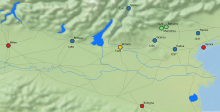Ezzelino III da Romano
This article includes a list of general references, but it lacks sufficient corresponding inline citations. (June 2019) |
Ezzelino | |
|---|---|
| Podestà of Verona | |
 16th century woodcut of Ezzelino III da Romano. | |
| Reign | 1226–30, 1232–59 |
| Successor | Mastino I della Scala |
| Other titles | Podestà of Padua (1236–59) Podestà of Vicenza (1237–56) |
| Born | 25 April 1194 Tombolo |
| Died | 7 October 1259 (aged 65) Castle of Soncino |
| Family | Ezzelini |
| Spouse | Selvaggia of Hohenstaufen
(m. 1236; died 1244)Beatrice di Buontraverso
(m. 1244) |
| Father | Ezzelino II da Romano |
| Occupation | statesman, commander |
Ezzelino III da Romano (25 April 1194, Tombolo – 7 October 1259) was an Italian feudal lord, a member of the Ezzelini family, in the March of Treviso (in modern Veneto). He was a close ally of the emperor Frederick II (r. 1220–1250), and ruled Verona, Vicenza and Padua for almost two decades.[1] He became infamous as a cruel tyrant, and was, in fact, the most "notorious" of the "early tyrants".[2]
Biography
Early life
Ezzelino was a son of
Rise to power 1226–1239
When Ezzelino II retired to a monastery in 1223, his possessions went to his sons Alberico, who received the castles and villages in the countryside of Vicenza (including the important centre of Bassano del Grappa) and Ezzelino, who received the possessions in the countryside of Treviso. In 1226 Ezzelino intervened in a factional struggle in Verona, aiding the Monticuli and Quattuorviginti against their enemies, the so-called pars comitis ("party of the count"), which was headed by the Veronese count Richard of San Bonifacio. From this time onwards Ezzelino became an important factor in Veronese politics and in 1226-1227 he had become podestà or Lord Mayor of that city. He briefly lost Verona, but regained it in 1230.[3]
At this time control over Verona was important because Frederick II was in conflict with the Second Lombard League, an alliance of cities in Northern Italy. Whoever controlled Verona could block the Brenner Pass through the Alps, and thereby prevent the arrival of reinforcements for Frederick from Germany. Initially, Ezzelino favoured the Lombard League which could block the Brenner and emerge victorious from its first confrontation with the Emperor. However, he and his brother Alberico later changed sides, when it became apparent that the League favoured their enemies in the March, particularly the Este and the San Bonifacio (Sambonifacio).
In 1232 the brothers struck an alliance with Frederick and received an imperial privilege of protection. However, four years passed before the emperor could personally intervene in the March of Treviso. The years 1232–1236 were therefore very difficult for Ezzelino and Alberico, who were assailed by many enemies, primarily the San Bonifacio, the Este and the city of Padua.
In 1236, Frederick II finally arrived in the March of Treviso. Because Ezzelino and his Veronese allies, the Monticuli and Quattuorviginti, had gained control of Verona in early 1236, the emperor could bring reinforcements across the Alps, including 3000 German men-at-arms. In a campaign that began in November 1236 Frederick and Ezzelino, who was becoming an increasingly important ally of the emperor, subjugated all the important cities of the March of Treviso: Vicenza was conquered in November 1236, Padua and Treviso surrendered in February/March 1237.

In 1236 Ezzelino married Selvaggia, Frederick's natural daughter who was thirteen years old at the time; conquered Verona and by treason Padua, seizing the position of podestà of that city. In Padua he had the monk Giordano Forzatè arrested and exiled.
Ezzelino was one of the protagonists in the Ghibelline-Imperial victory of
Last years
After a failed pacification attempt by Frederick, as soon as the emperor departed Ezzelino attacked the Este, submitting Treviso - even though it was his brother's fief -
After Frederick's death in 1250, Ezzelino supported his son,
It was only after his death that the alliance between Sambonifacio and Este fell apart.[1]
Legacy
Much of what we know about Ezzelino comes from a literary tradition that was embroidered over the course of centuries; despite the brevity of his reign, Ezzelino's reputed cruelty became symbolic of tyranny, poets and chroniclers living in recent memory of his tactics used his name to evoke the sense of arbitrary power and the moral transgressions it enabled; fourteenth century authors raised the level of accusation, insisting that Ezzelino's parentage was demonic. Rolandino of Padua's Chronicle of the Trevisan March (c. 1262) charts the rise and the fall of the 'da Romano' family, introducing Ezzelino as a young man throwing stones at the home of the family rival; the extremely partisan political work follows the fortunes of Padua under the tyrant's iron grip up to the commune's liberation by the Guelph League. Albertino Mussato's Ecerinis ( c. 1315 ) portrays Ezzelino as the son of the Devil; the Latin verse play introduces Ezzelino's mother, who provides testimony of the tyrant's infernal sire. In
Before Ezzelino, the seizing of political power in city-states throughout the Middle Ages, had been based on real or pretended inheritance claims or else were directed against infidels and the excommunicated; but with him, as the historian
See also
References
- ^ a b Dean 1999, p. 460.
- ^ Dean 1999, p. 459.
- ^ a b c d Chisholm, Hugh, ed. (1911). . Encyclopædia Britannica. Vol. 8 (11th ed.). Cambridge University Press. pp. 846–847.
- ^ Jacob Burkhardt, The Civilization of the Renaissance in Italy, Introduction.
Sources
- Dean, Trevor (1999). "The rise of the signori". In Abulafia, David (ed.). The New Cambridge Medieval History (Vol. 5): c. 1198-c. 1300. Cambridge University Press. ISBN 978-0521362894.
External links
- Summary of Ezzelino's deeds (in Italian)
